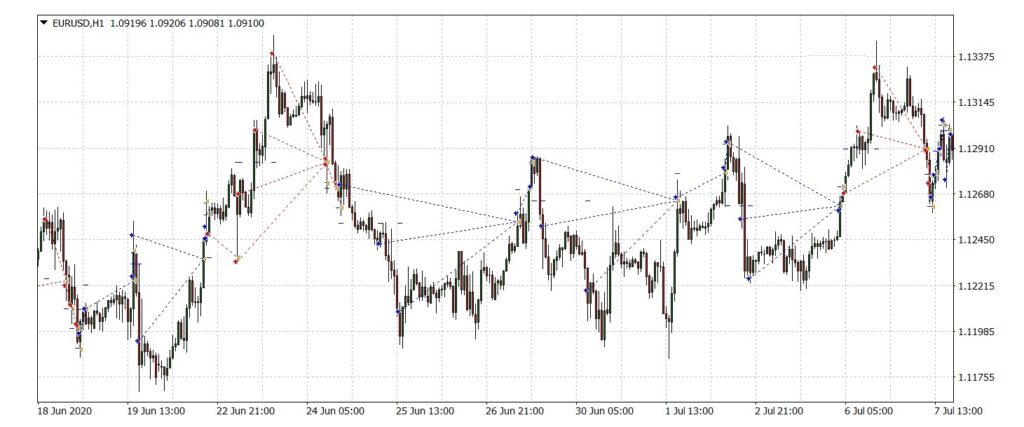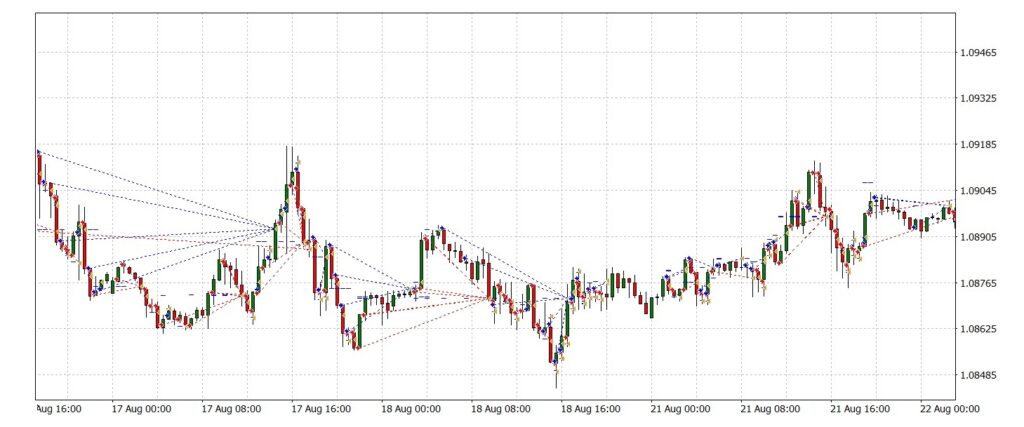
So, today, we're peeking into the world of day traders and their playbook. We've checked actual trader accounts to see the most popular strategies. From zigging when the market zags with counter-trend trades to quick wins with scalping and the classic trades with support and resistance levels. Oh, and there’s something about making moves at just the right time of day that's pretty clever, too. Whether you're in the game or love hearing about the wild world of forex trading, you will want to stick around for this. So, let's roll up our sleeves and jump right in!
DAY TRADING
Day trading is as an umbrella term that encompasses a variety of strategies used to trade financial instruments within the same trading day. For the average Joe without the help of trading robots, this method often feels like gambling on a slot machine: lots of action and a rush of adrenaline, but profits are often miniscule. The math and probability aren’t in the trader’s favor. Think about it – betting on red or black in a casino gives you a 50/50 shot, but in Forex, the odds are even slimmer thanks to factors like the spread.
Right off the bat, opening an order puts you at a disadvantage. Plus, traders have to nail both the direction of the market and the timing of their moves. With all these hurdles, it’s way more likely to lose than win, and yes, many do lose – some even dive in with gusto. However, a small group of day traders succeed, raking in profits that can soar into the tens of thousands.
The typical successful day trader often starts as a mystery client, showing up out of nowhere and suddenly opening 3-5 trading accounts, each loaded with 40-50 thousand dollars or its crypto equivalent. They dive into day trading on all fronts, managing all these accounts simultaneously. It’s common to see them mirror the same trades across each account, thanks to trade copiers focusing on the same currency pairs. Then, about two or three days later, they wrap things up in a blink. All accounts are emptied, and profits and initial deposits are withdrawn to the last cent. Soon after, the cycle might restart, sometimes with the money coming from someone else, say a brother-in-law. This trading blueprint, especially favored by Chinese traders, involves making quick profits, often from trading gold or more exotic currencies like the MXN, before making a swift exit.
SCALPING
Scalping is a whole different beast. This family of forex trading strategies is all about making quick hits. It is a pure day trading strategy. A trader jumps in and out of trades in a blink (we’re talking 1 to 3 seconds) to snatch up small profits from tiny price shifts. Think of it as trying to grab a dollar or ten with every lot all day long.
People often confuse scalping with pipsing, but they’re different beasts. With pipsing, you might find yourself holding onto an order for a few hours if things don’t go your way. Both strategies are about chasing small profits, often just a few pips that might barely cover the spread. Scalping’s fast pace usually means robots are the go-to. On the other hand, traders can engage in pipsing manually.
The kicker with these strategies is the hit you take from spreads. For this reason, retail traders gravitate towards pairs with the lowest spreads, like EURUSD. This preference is a big reason it’s the most traded pair in the over-the-counter Forex market. While scalping has its tricks for turning a profit, we’ll dive deeper into those in upcoming posts.
NEWS TRADING
Forex trading strategies from this family specifically aim to capitalize on the market movements triggered by major economic news and events, which can significantly influence currency rates. This strategy is distinct from Fundamental Analysis trading. Here’s how. News traders place their bets just before, during and right after the release of economic data when market volatility is at its peak. For instance, they might focus on interest rate decisions, employment reports, or GDP announcements, which can lead to swift and substantial currency movements.
The tricky part is that currency pairs don’t always behave as expected around these news releases. For example, while an interest rate hike should theoretically boost its currency, the actual market reaction might be unexpected. The market may move sharply in the opposite direction, creating a “storm” that wipes out stop-loss orders.
We knew this trader who would only make two or three trades a month. He did so consistently and profitably. Starting with a kitty of around USD 10-15 thousand, he could net an extra three to four thousand dollars each month by leveraging just two or three pieces of news. We’ll dive deeper into how to analyze such data and craft strategies around it in future articles.
TRADING OVERLAPPING TRADING SESSIONS
These strategies focus on the action during overlapping trading sessions, especially at two critical moments: the start of the American session at 8 a.m. (EST) and the closing of the trading day at 5 p.m. (EST), also known as the rollover period. This strategy pays close attention to the 30 minutes before and the 60 minutes after these key times (in Central European Time). Traders utilizing this strategy often open and close trades within these specific windows to take advantage of increased liquidity and volatility, aligning with day trading’s short-term nature.
What makes the end of the trading day, or the rollover, so intriguing is the flurry of activities happening behind the scenes with banks, prime brokers, prime of primes and other market participants. Any glitches During this window can give savvy traders golden opportunities for quick gains. For example, spreads at prime brokers might momentarily drop to zero or even go negative, only to widen substantially shortly after. It’s a magical time filled with potential surprises, akin to a “forest filled with wandering spirits. We plan to explore rollovers in-depth in a future article, including how swap charges play into profit-making strategies. Some traders specifically leverage these moments to boost their earnings.
Sure, there are instances of people landing some quick and easy profits. We’ve witnessed it firsthand. However, whether or not these novice traders can actually pocket those profits is a whole different matter. If someone manages to scoop up a modest $2-3 thousand overnight in a single account, chances are their broker will allow them to withdraw this profit. But if the earnings are more substantial, there’s a risk the broker could invalidate them. This is why savvy traders distribute large deposits over several accounts—to avoid attracting too much scrutiny. Yet, this tactic doesn’t always work under the radar. Brokers don’t just watch individual accounts; they monitor all accounts linked to a specific user profile.
Making money by gaming the system is frowned upon and considered fraudulent. A broker has every right to wipe those profits and reverse the trades. And if traders complain about such decisions, regulatory bodies typically back the broker aligning with the principles of fairness and upholding the integrity of the global capital markets
COUNTER TREND TRADING
These forex trading strategies aim to go against the current trend, seeking to enter or exit the market at the peaks or troughs of price fluctuations. This approach is quite popular among traders and can be applied to day trading as well as mid to long-term trading strategies. Nowadays, nearly all trading robots use it. Do you know how trading robots (or expert advisors) usually start trading? They often place their first orders against the trend. But here’s the deal: trends take time to develop. Prices might swing quite a bit before it’s clear that a new trend is starting. So, by the time you’re sure, you’ve missed a chunk of the action. That’s why most of these bots jump in without waiting for a solid sign of a new trend, which means they often find themselves on the wrong side of the market moves.
This trading strategy can be divided into Grid and Martingale strategies:
- The Martingale trading bots up the ante with larger volumes at every new dip or peak.
- The Grid-based bots place buys and sells at different levels, betting both ways.
Take a gander at the screenshot we’ve got.

Every subsequent order placed by Expert Advisors based on Martingale has the volume larger than the previous one.
Grid and Martingale strategies are very similar.

Grid-based Expert Advisors open orders of approximately the same size.
Blue dots on both images represent buy orders, and red dots represent sell orders. That EA closes all orders almost simultaneously, slightly above the break-even price. Doing this manually is tough, so it’s often left to trading robots (Expert Advisors).
Martingales and Grids are the most frequently used strategies in retail trading. The main difference is how orders are placed at each new level. With Martingales, each new order is opened with a larger volume than the previous one. Meanwhile, Grid strategies allow orders to be opened at new levels with the same volume. Additionally, Grids can open combined buy and sell orders within the same market movement. On the other hand, Martingales only open orders of one type per trading cycle. This is because Martingales require an even larger volume with each new level, significantly increasing the margin – the collateral amount.
TREND TRADING
Trend Trading is exactly what it sounds like. Forex trading strategies of this type follow the market’s current trend. The goal is to take positions that align with the market’s movements, which makes it adaptable to different trading styles and time horizons, depending on the trader’s goals, risk tolerance, and analysis of market dynamics. It is a versatile strategy that traders can apply over various timeframes, including intraday (within a single trading day), medium-term (over days to weeks), and long-term (months to years).
These strategies are smart and have proven to work well. Yet, traders often find it hard to stick to it with discipline. We plan to dive deeper into Trend Trading in a separate post, breaking it down with examples and giving it the in-depth look it deserves.
INDICATOR-BASED TRADING
These forex trading strategies rely on technical indicators, such as moving averages and the Relative Strength Index (RSI), to guide traders on when to enter and exit trades. Strategies from this family are also universal in nature and can can be adapted for intraday trading.
This method had a huge following up until about 2012. Back then, trading forums were alive with chatter about various strategies using various indicators. There were endless debates on the superior choice: moving averages or combining stochastics with parabolics. However, this kind of debate has cooled off over the years. Nowadays, the community’s interest has shifted more towards fine-tuning the performance of specific trading advisors, such as the Phoenix EA we touched on before. This includes a keen interest in those utilizing Martingale strategies.
SUPPORT AND RESISTANCE-BASED TRADING
When it comes to Forex trading, many traders swear by Support and Resistance Levels. This forex trading strategy is basically about spotting those spots on the chart where the price seems to hit a wall or bounce back—it’s like finding the price’s comfort zone. This method’s been around the block and still holds its ground because, well, it works.
Now, depending on how long they like to keep their trades open, traders get divided into camps. The fast movers jump on those moments when the price decides to break out of its comfort zone, while the ones playing the long game use these levels along with trend lines to sort of map out where the price might head next.
This whole support and resistance thing isn’t just a quick fling; it’s more of a long-term relationship. It’s usually the go-to for people who are more into investing than the adrenaline rush of day trading, ready to sit tight on their positions for weeks if they have to. And guess what? There are many stories of people making a pretty penny with this approach. We plan to get into this strategy’s nitty-gritty in some upcoming posts, so keep an eye out for them. Please note however, that the use of this strategy is not exclusively limited to day trading and may also be applied in longer-term trading approaches.
CANDLESTICK PATTERN TRADING
Forex trading strategies from this family try spotting specific formations in candlestick charts. They look for patterns like the “Hammer” or “Inverse Head and Shoulders” to guide them when entering the market. This universal strategy is adaptable to both day trading and longer-term trading, making it a valuable tool for traders across various timeframes.
This strategy used to be all the rage, but since around 2012, its appeal has waned. The main hurdle is the vast array of “patterns” that traders need to identify and commit to memory. Lately, people have been shying away from the effort to learn and remember these intricate patterns, opting for simpler trading strategies. As a result, this kind of “knowledge” has increasingly become the specialty of Forex “aficionados.”
Last time, we dug into the Phoenix EA story, examining its inner workings and pinpointing why it fell short. Coming up? We’re going to get into the nitty-gritty of scalping.
Happy trading, everyone!
DISCLAIMER! The contracts for difference (CFDs) we discuss come with high risks, and you could lose all the money you put in. Make sure you understand all the risks involved before you dive in.




